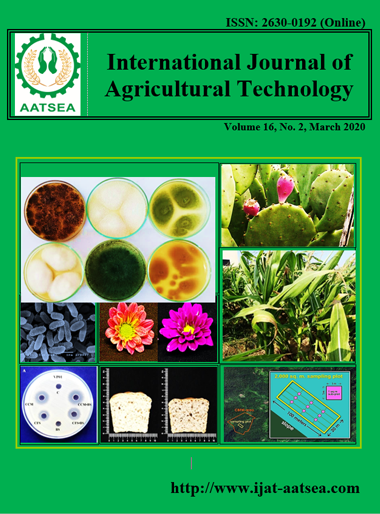Development of grass jelly processing using modified starches and higher efficient extraction method
Main Article Content
Abstract
The grass jelly stalks was extracted using pressure cooker at 117oC for 30 minutes and followed by boiling under atmospheric pressure for 60 minutes to get the total solid content (%) in grass jelly solution resulted non-significantly different from the traditional boiling for 3 hours. The pea starch and 3 types of modified starches (KSA1502, ET50, and ESH15) at 5 % by solution weight were improved the grass jelly texture. The grass jelly from KSA1502 had hardness, springiness and gumminess that did not significantly different from the control (tapioca starch). Finally, the grass jelly solution was extracted by reducing grass jelly stalks for 30% from the control formula, and using 2% KSA1502 with gelatin 2.5 % together with varying tapioca starch to 4 levels as 0, 1, 2 and 3% by solution weight. It was found that the formula using 2% KSA1502 along with 1% tapioca starch and 2.5% gelatin by weight to receive the best texture properties and sensory scores in all attributes.
Article Details

This work is licensed under a Creative Commons Attribution-NonCommercial-NoDerivatives 4.0 International License.
References
A.O.A.C. (1997). Official methods of analysis of AOAC. 16th ed. The Association of Official Analytical Chemist, Gaithersburg, Maryland.
Apicharsrangkoon, A. and Ledward, D. A. (2002). Dynamic viscoelastic behavior of high- pressure-treated gluten–soy mixtures. Food Chemistry, 77:317-323.
Bemiller, J. and Whistler, R. (2009). Starch: Chemistry and Technology 3rd ed., Academy press, New York, pp.746-788.
Blandino, M., Sovrani, V., Marinaccio, F., Reyneri, A., Rolle, L., Giacosa, S., Locatelli, M., Bordiga, M., Travaglia, F., Coïsson, J. D. and Arlorio, M. (2013). Nutritional and techno-logical quality of bread enriched with an intermediated pearled wheat fraction. Food Chemistry, 141:2549-2557.
Bush, A. (2006). Inside the greenhouse. Retrieved from http://austinbushphotography.com.
Clarissa, W. (2016). Sweet, black grass jelly shouldn't come out of a can. Retrieved from https://www.vice.com.
Handayani, D., Dewanti, T. W., Novita, W. and Hanifa, M. E. H. (2017). Black grass jelly (Mesona palustris Bl) effervescent powder has anti-dyslipidemia in high cholesterol diet-fed rats and antioxidant activity. Research Journal of Life Science, 4:2355-9926.
Imeson, A. (2010). Food stabilisers, thickeners and gelling agents, Wiley-Blackwell, London, pp.145-166.
Korir, P. C., Salim, A. M., Odalo, J. O., Waudo, W., Gitu, L. M. and Yusuf, A. O. (2018).
Optimization of Extraction Condition and Characterization of Malva Verticillata Root Bark Mucilage. International Journal of Chemistry, 10:1-9.
Kreungngern, D. and Chaikham, P. (2016). Rheological, physical and sensory attributes of Chao Kuay jelly added with gelling agents. International Food Research Journal, 23:1474-1478.
Lim, T. K. (2012). Edible medicinal and non medicinal plants: volume 3, Fruits, Springer Science & Business Media, pp.379-383.
Liu, S., Lin, L., Shen, M., Wanga, W., Xiaa, Y. and Xie, J. (2018). Effect of Mesona chinensis polysaccharide on the pasting, thermal and rheological properties of wheat starch. International Journal of Biological Macromolecules, 118:945-951.
Ratnayakea, W. S., Hoovera, R. and Warkentinb, T. (2002). Pea Starch: composition, structure and properties - A Review. Starch/Stärke, 54:217-234.
Wittayapanyanon, S. (2012). Technique for grass jelly production (in Thai). Retrieved from http://www.budmgt.com/tech/.
Wang, S., Li, C., Copeland, L., Niu, Q. and Wang, S. (2015). Starch retrogradation: A comprehensive review. Comprehensive Review in Food Science and Food Safety, 14:568-585.
Wititsiri, S. (2014). The Comparison of pectin quantities from stringy pulp of Nanga Jackfruit (Juampa Krop) between hot water and high vapor pressure extractions. Journal of Yala Rajabhat University, 9:95-112.
Xiao, Y., Liu, S., Shen, M., Jiang, L., Ren, Y., Luo, Y. and Xie, J. (2020). Effect of different Mesona chinensis polysaccharides on pasting, gelation, structural properties and in vitro digestibility of tapioca starch-Mesona chinensis polysaccharides gels. Food Hydrocolloids, 99. DOI: 10.1016/j.foodhyd.2019.105327.
Zaid, R. M., Zularisam, A. W. and Sakinah, A. M. M. (2016). Effect of process parameters on pectin extraction from dragon fruit (Hylocereus polyrhizus) peels via chemical and physical treatment. Australian Journal of Basic and Applied Sciences, 10:69-74.


